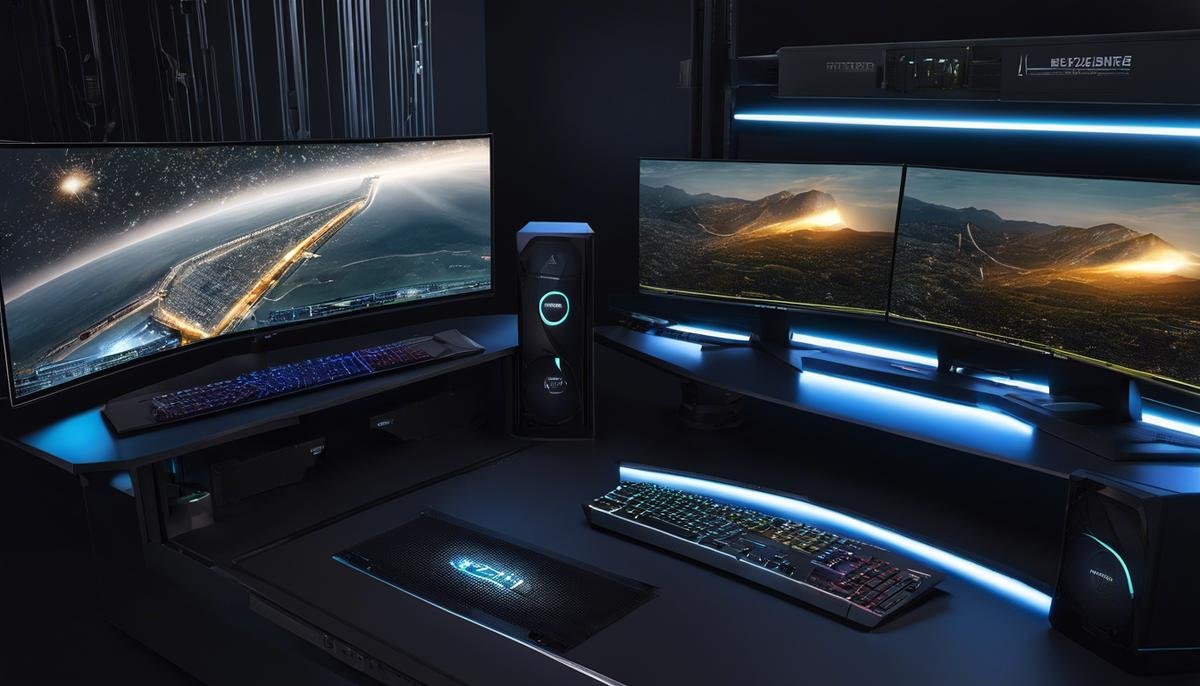As technology continues to advance in leaps and bounds, artificial intelligence remains at the forefront of these transformations, altering everything from our daily interactions to the global economy. A prime instance of this is Dall-E, an AI image-generation system pioneered by OpenAI, which has transformed the landscape of digital representation by generating unique images from simple textual descriptions. This essay endeavors to offer a comprehensive understanding of Dall-E, including its technical details, setup procedures, troubleshooting, and a glimpse into its promising future.
Understanding Dall-E
Think about the last time you were awestruck by the power of imagination. Maybe it was a surreal Salvador Dali painting or a whimsical Dr. Seuss book. The human mind seems unparalleled and uncontested in its ability to combine unrelated things to create incredibly diverse images. But wait! There’s a gamechanger on the horizon – DALL-E, the artificial intelligence (AI) program developed by OpenAI.
Born from the tie-up between two highly sophisticated AI models, DALL-E has intelligence, creativity, imagination, and then some! It’s essentially a variant of GPT-3, the revolutionary language processing AI, but with a twist. Instead of generating text, this AI generates images. It’s like a magic carpet ride into the future of technology.
So, how does DALL-E work? Picture this. You type in a seemingly absurd phrase, say, “an armchair in the shape of an avocado.” Within moments, DALL-E will serve you up a selection of images, each visualizing in different ways, your avocado-shaped armchair. Mind-boggling, isn’t it?
At the heart of DALL-E’s functioning is a concept called “Transformer neural networks.” This technology was originally used for understanding natural language processing and translation, but DALL-E adapts it to create images. It shows the AI a lot of pictures and their related text descriptions, helping it learn to understand language and image associations. This way, DALL-E can generate images directly from textual descriptions, much like how a human artist would.
But what makes DALL-E stand out in the crowd of AI? The ordinary neural networks can only generate images based on their existing data bank. However, DALL-E can create never-seen-before images by understanding the crux of your request. It learns like a human by connecting dots and blending different ideas.
Understandably, there might be concerns about how DALL-E could be misused. Misrepresentation, copyright issues, and authenticity are possible pitfalls. But OpenAI, glowing with enthusiasm yet grounded with responsibility, has reassured us that regulations and ethical standards are on their priority list.
Technology’s wild ride has just got wilder with DALL-E, taking imagination to the computational table. It’s a big leap for AI, pushing the boundaries of creativity and technology and bridging the gap between the human mind and artificial intelligence. Simple words transformed into vivid and varied imagery – the future is right here, right now. Buckle up, because this journey with DALL-E is just getting started!

Dall-E Technical Specifications
Running DALL-E Successfully: The Tech Specs Unveiled
For those intrigued by the audacious capabilities of DALL-E, your next question is likely to be: what are the technical requirements to run this wickedly smart AI? Well, let’s dive in and quench your tech thirst!
Hardware Requirements:
Keep in mind that the Transformer networks powering DALL-E are truly data-hungry and demand significant processing power. Therefore, expect high-end hardware requirements. A high-powered GPU becomes a necessity considering the magic DALL-E conjures up. CUDA-enabled GPUs with high-memory, like Nvidia’s Titan RTX or A100, would potentially hold up under the monumental task of running DALL-E.
Let’s not forget that DALL-E will require sheer memory space. To handle the intricate details of millions of tokens, the presence of substantial RAM, ranging into several hundred gigabytes, becomes inevitable.
Software Requirements:
When embarking on the journey of running DALL-E, it’s not just about the hardware, but the correct software environment is equally crucial. Running on Python, you’ll need the latest version and associated libraries like PyTorch, TensorFlow, and Keras, vital to handle neural networks.
Speaking of software, managing and storing the vast data that comes with DALL-E cannot be overlooked. The implementation of robust and reliable database systems ensures smooth execution and easier management of data.
Flexible Cloud and Networking Infrastructure:
One must not underestimate the importance of an impeccable hosting and networking infrastructure. Considering the data-intensive nature of DALL-E, it necessitates a high-speed internet connection for seamless data transfer.
Moreover, having a flexible cloud infrastructure would be beneficial in the long run. It not only provides a robust platform but permits scalability when DALL-E starts desiring more memory space or computational power.
Expertise and Training:
Last of all, the very ability to operationalize and manage DALL-E is a pressing requirement. It needs proficient knowledge and skill sets in Artificial Intelligence, Deep Learning, advance library management, cloud computing, and data managing systems. Plus, given the complex nature of DALL-E, continuous learning, and regular updates on technological advancements are absolutely essential to unlock its full potential.
Remember, beyond these technical requirements, OpenAI has kept DALL-E’s exact specifications top-secret, making emulation a tricky endeavor. Until and unless OpenAI decides to unwrap more details, we can only wait and sharpen our skills in anticipation. However, having a basic understanding of these prerequisites provides a framework to support AI marvels like DALL-E.

Setting Up Dall-E
Despite the critical knowledge laid out about DALL-E, we’re still left with the question: How can one set it up? While OpenAI is yet to release precise steps, certain prerequisites surrounding both hardware and software can be inferred at this stage.
Embarking on your adventure with DALL-E starts with fulfilling the hardware requirements. A robust system with high-powered GPUs is non-negotiable. Think along the lines of Nvidia’s latest GeForce or Tesla cards for this transformative tech. DALL-E is memory-hungry too, anticipating a substantial amount of RAM, likely no less than 16GB, although more is always better when it comes to AI.
The software setup, on the other hand, will likely require a firm hold over Python, the reigning language in AI applications. Additional proficiency in libraries like PyTorch, TensorFlow, and Keras, all critical for developing and running machine learning applications, would be equally important.
The significance of database systems isn’t lost with DALL-E. Given its ability to produce vast data through generated images, a robust and reliable database system for managing and storing this data efficiently will be key.
Another facilitator for DALL-E’s functioning would be a high-speed internet connection, aiding in smooth data transfer. You’d also need an adjustable cloud infrastructure to ensure scalability. This means services like AWS, Google Cloud, or Microsoft Azure should be within your technical competence.
Finally, setting up DALL-E can’t be done without considerable expertise and training in areas such as artificial intelligence, deep learning, library management, cloud computing, and data management systems.
The lack of details surrounding DALL-E’s specific setup may seem like a hurdle. However, it’s important to note that this secrecy is due to OpenAI’s responsibility to prioritize ethical considerations and avoid misuse. Information will likely be shared when it can be done safely.
While we wait for more concrete details, you can start preparing based on these prerequisites. The world of AI is evolving rapidly, and DALL-E is a good reminder that staying ahead requires both patience and flexible skill development. Immerse yourself in the necessary learning endeavors and gear up to embrace this thrilling evolution of AI. Stay tuned for more as we continue to explore the awe-inspiring realm of DALL-E.

Potential Issues and Solutions
Let’s now delve into some common issues linked with DALL-E, and more importantly, how to resolve them.
To start with, DALL-E presents several challenges, especially in its interpretation and execution of prompts. Even with the most accurate prompts, DALL-E can occasionally produce images that deviate significantly from the expected output. This irregularity in remaining true to the prompt can be a hurdle, particularly for professional applications looking for precision. Of course, as with any AI model, continuous training and refinement of the algorithm can mitigate this issue.
Secondly, DALL-E may struggle with novel concepts or elements outside its trained database. This means tasks outside DALL-E’s gamut – which is every image seen on the internet – could pose a challenge. Collaboratively, the AI community and OpenAI can work towards expanding algorithms to understand and handle unfamiliar concepts, thereby reducing their reliance on previously seen images.
Thirdly, as it stands, DALL-E lacks a sophisticated ability to understand context. This limitation results in images that are technically correct but awkward or nonsensical in relation to real-world logic. Advanced AI models currently in development aim to overcome this by integrating higher levels of natural language processing and contextual understanding.
Another operational issue is DALL-E’s high rate of energy consumption. While this is standard for high-functioning AI programs, it raises environmental concerns, given the global push towards energy efficiency. AI optimisation techniques and energy-efficient hardware innovations may serve as practical solutions here.
While OpenAI has implemented guidelines to prevent DALL-E from generating inappropriate or harmful images, there’s always a risk of misuse. Building rigorous security measures into the model can enhance safety and responsibility in AI technology application.
Lastly, the DALL-E model, being proprietary, isn’t easily accessible for most developers and researchers. This lack of access prevents widespread analysis, testing, and improvement. Professional dialogue and potential open-source directions could temper this accessibility issue.
Indeed, DALL-E, like the rest of us, has its strengths and weaknesses. However, with a proactive AI community and relentless innovations, we are bound to see progress. Therein lies the beauty of technology – its inherent ability to evolve and improve. As tech enthusiasts and problem solvers, we can’t help but anticipate the better, stronger DALL-E that the future holds.

The Future of Dall-E
The crystal ball of the tech scene never stays clear for long. Another wave is ever looming, and in this case, it’s the developing narrative of DALL-E. Where does DALL-E go from here? What futurescape does it help sketch out for the world of technology?
One of the first answers lies in the realm of job adaptation. While it’s instinctive to envision a dystopia where AI takes over human jobs, the reality might just turn into a productive collaboration instead. DALL-E could very well become a tool in a designer’s arsenal, not a replacement. The possibility of synthesizing intricate and revolutionary designs at the click of a command could help creators devise more unique visuals, assisting in tasks where manual execution may demand a substantial duration.
Further, from an educational standpoint, DALL-E could become a revolutionary tool. Picture an interactive school project where kids work with AI to produce captivating graphics. Such experiences could inspire them to learn more about AI, feeding their creativity and understanding of technology. With DALL-E’s ability to materialize abstract ideas, this could boost learning considerably, making subjects more engaging and interactive for students.
In the digital art and entertainment industries, this AI model could be the next big game-changer, crafting novel, dynamic, and never-seen-before digital illustrations. It could breathe life into vague thoughts, propelling the animation and video game industries to unseen territories. Imagine a video game designed with DALL-E at the helm, where each player experiences a unique environment moulded by their input.
There is another society-transforming angle to consider – accessibility. Particularly, in an environment where ‘seeing is believing,’ metamorphosing textual descriptions into visual reality could be path-breaking. From an accessibility standpoint, this has far-reaching implications. People with reading challenges or visual impairments could experience content in new ways, breaking down barriers and fostering inclusivity.
However, with the surge of developments and the embrace of AI-powered solutions, the big challenge is to ensure the controlled democratization of technology like DALL-E. It necessitates a globally accepted regulatory framework that balances harnessing AI’s creative potential with its ethical, philosophical, and societal implications. Even the OpenAI charter maintains its commitment to ensure AI benefits all of humanity. It’s no small task, but it’s possible with widespread cooperation.
The road ahead for DALL-E, no doubt, is dynamic, laden with challenges and teeming with opportunities. As technology enthusiasts who thrive on problem-solving, it’s our prerogative to ensure AI propels society forward, not drive it off a cliff. DALL-E’s future hangs in the balance between responsible use and progressive innovation, and it’s up to tech enthusiasts around the globe to determine its path. How this swing will rock will, someday soon, stop being a matter of speculation and start being our pixelated reality. Brace yourselves; the future is shaping up to be quite a ride.

The potential that Dall-E holds is monumental. As this revolutionary sysytem continues to evolve, it’s poised to transform our ideas about art, design, visual media and indeed, our understanding of AI’s capability itself. OpenAI, through Dall-E, is undoubtedly paving a path into a future that integrates AI more fluidly in our lives. By comprehending its operation, troubleshooting issues, and anticipating its future permutations, we are in essence, preparing for an era where AI is interlaced with our existence – shaping and being shaped by our creativity, needs, and curiosity.




